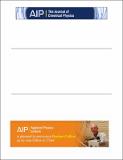Por favor, use este identificador para citar o enlazar a este item:
http://hdl.handle.net/10261/102521COMPARTIR / EXPORTAR:
 SHARE SHARE
 CORE
BASE CORE
BASE
|
|
| Visualizar otros formatos: MARC | Dublin Core | RDF | ORE | MODS | METS | DIDL | DATACITE | |

| Título: | Strongly mixed resonances in the photofragmentation of HeBr2 near Br2(B) dissociation: Stabilization and close-coupling studies |
Autor: | González-Lezana, Tomás CSIC ORCID ; Hernández, Marta I. CSIC ORCID; Delgado Barrio, Gerardo CSIC ORCID ; Villarreal, Pablo CSIC ORCID | Palabras clave: | Dissociation Dissociation energies Wave functions Molecular dissociation Excited states |
Fecha de publicación: | 1997 | Editor: | American Institute of Physics | Citación: | Journal of Chemical Physics 106: 3216- 3226 (1997) | Resumen: | The photofragmentation of the He79Br2 van der Waals complex is studied for the transition from the ground to the excited electronic state B and where the Br2 subunit is also excited to the neighborhood of the v0 = 45 vibrational state. At this vibrational level the bromine molecule is close to its dissociation limit and the Δv = - 1 channel is closed for dissociation of the complex. In a previous work it was suggested that energy in the HeBr2(B, v0 = 45) quasibound state may be internally redistributed (exciting van der Waals modes at the expense of the bromine excitation) poor to dissociation. Such mechanisms are more deeply studied in this work by means of the stabilization method, which works with square-integrable wave functions and is an appropriate approach to perform quasibound state analysis. Stabilization total cross sections compare fairly well with close-coupling ones, where the proper asymptotic behaviour of the continuum wave functions is taken into account. By inspection of the quasibound state wave functions, it is seen that energy is redistributed to several excited states belonging to the v0 - 1 manifold. In addition, it is shown that such excited states also carry oscillator strength in the transition from the ground electronic state and thus interference effects in the excitation process are significant. HeBr2 near the halogen dissociation limit is found to be a rather strongly coupled system where the quasibound states involved can only approximately be assigned to quantum numbers corresponding to interhalogen and van der Waals vibrational excitations. © 1997 American Institute of Physics. | URI: | http://hdl.handle.net/10261/102521 | DOI: | 10.1063/1.473421 | Identificadores: | doi: 10.1063/1.473421 issn: 0021-9606 |
| Aparece en las colecciones: | (CFMAC-IFF) Artículos |
Ficheros en este ítem:
| Fichero | Descripción | Tamaño | Formato | |
|---|---|---|---|---|
| TGLezana.pdf | 420,49 kB | Adobe PDF |  Visualizar/Abrir |
CORE Recommender
SCOPUSTM
Citations
21
checked on 12-abr-2024
WEB OF SCIENCETM
Citations
23
checked on 24-feb-2024
Page view(s)
266
checked on 23-abr-2024
Download(s)
288
checked on 23-abr-2024
Google ScholarTM
Check
Altmetric
Altmetric
NOTA: Los ítems de Digital.CSIC están protegidos por copyright, con todos los derechos reservados, a menos que se indique lo contrario.
